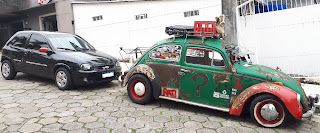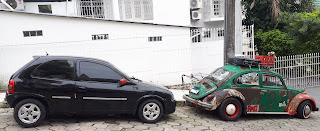Monday, October 25, 2021
Color-matching tail lights: a reminiscence from mid-'90s
Monday, October 04, 2021
Dina D9400, a Mexican rebadged International 9400
Friday, October 01, 2021
Volkswagen Beetle and Opel Corsa B: two remarkable generations of "people's car" in contrast
Another small car which had a noticeable role at the time of its release both in Brazil and Mexico, and a fierce competitor to the Beetle by the way, the Opel Corsa B was rebadged in Brazil as Chevrolet Corsa and in Mexico initially as Chevrolet Chevy. Even though its technique was quite austere in accordance to the European perspective in '93 when it arrived in Mexico initially imported from Spain and in '94 at the beginning of local production in Brazil, this model is noticeable for undeniably turning the "people's car" segment all-around, as the first real contender to the Mexican Beetle locally called "Vocho", and in Brazil its relevance as a world-class small car going as far as pioneering the electronic fuel injection for entry-level models. Eventually the Opel Corsa B may not reach a similar cult status as the Beetle, yet it had a comparable role in a time when the "people's car" concept in Brazil had already been highlighting the preferences of a more city-oriented customer base.





